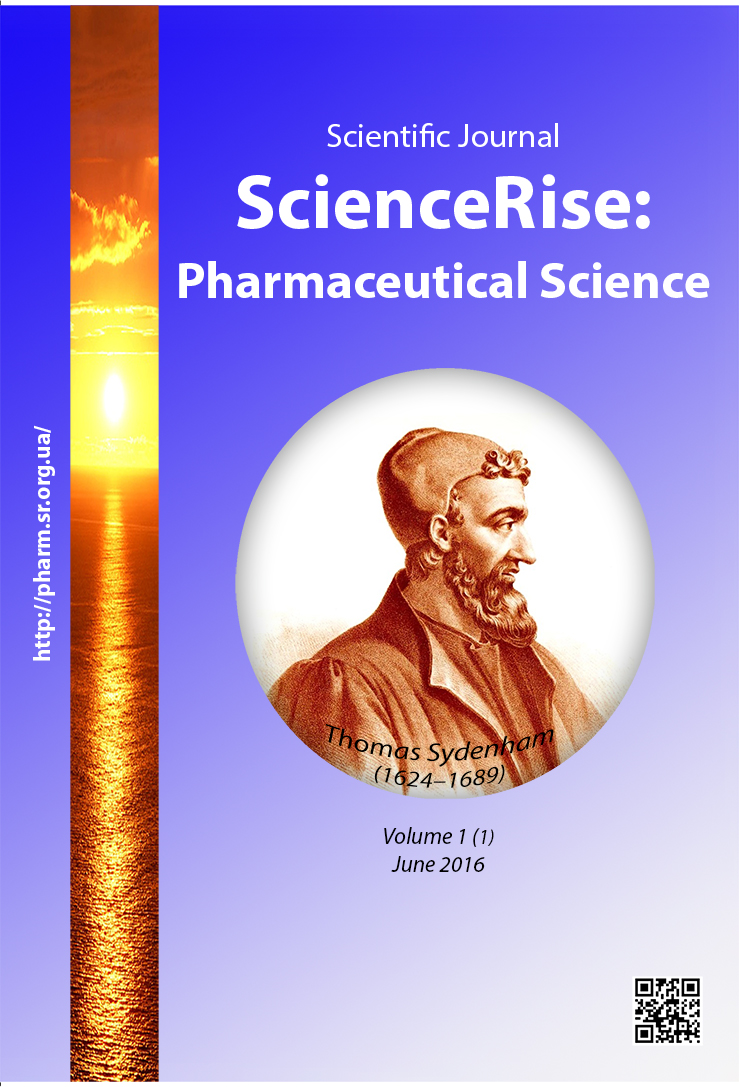Influence of gels containing glucosamine and silver nanoparticles on the peroxidation process under burn wounds conditions in rats
DOI:
https://doi.org/10.15587/2519-4852.2016.72814Keywords:
wounds, burns, gel, Silver nanoparticles, Glucosamine hydrochloride, lipids and proteins peroxidationAbstract
Burns ranks third in the overall structure of injuries. For efficient pharmacocorrection of burns, local medicines must show a complex effect on pathogenic process. Oxidative stress prevention in wound eliminates secondary necrosis development and creates favorable conditions for injured tissues regeneration.
Aim of the given research was to study the influence of gels containing Glucosamine and Silver nanoparticles on the proteins and lipids peroxidation processes under burn wounds conditions in rats.
Materials and methods. The second degree thermal burn injury was reproduced using special device with a metal plate with a diameter of 2.5 cm at the end. The exposure time of the contact plate heated to 200 oC was 4 sec. The gels were applied to the affected areas daily in the experimentally determined dose of 50 mg/cm2. Blood sampling for analysis was carried out in two periods: the 7th day of treatment, when the scabs began to peel, and the 15th day of treatment. Each 6 rats from every group were decapitated, and proteins oxidative level (aldehyde and ketone dinitrophenylhydrazones), lipids oxidative level (the content of diene conjugates and TBA-r), free SH-groups were determined.
Results. During the animal burns treatment by gel containing Glucosamine and gel containing Silver nanoparticles and Glucosamine, a reliable decrease in the intensity of proteins oxidative modification processes of 60 % and lipids peroxidation processes of 58 % happened. Normalization of organism antioxidative system was determined, which reduces oxidative stress effects and promotes injured tissues regeneration processes.
Conclusion. Pharmacological study of Silver nanoparticles and Glucosamine is promising for local wound-healing remedies of new generation creation and improvement of efficiency of wounds pharmacocorrection
References
- Krivoshapko, O. V. (2012). Rol’ protizapalnih tsitokiniv u mehanizmi hronizatsiyi opikovoyi rany [The role of inflammatory cytokines in the mechanisms of chronic burn wounds]. Kharkiv National Medical University, 23.
- Raskevich, O. S., Rozhkovskiy, Ya. V. (2012). Vpliv mazevoyi kompozitsiyi Marepolimiel na stabil’nist’ membrane ta aktivnist’ tsitolitychnikh protsesiv pry termichnomu opiku shkiry [Impact ointment composition Marepolimiel the stability of cell membranes and cytolytic activity of thermal processes in skin care]. Actual issues pharmaceutical and medical science and practice, 8 (1), 13–17.
- Yakovleva, L. V., Tkachova, O. V., Butko, Ya. O. (2013). Metodicheskiye rekomendatciyi “Eksperimental’ne doslidzhenn’a novyh preparative dlya mistcevogo likuvann’a ran” [Methodical recommendations "Experimental study of new drugs for the topical treatment of wounds"]. Kharkiv, 52.
- Nekrasova, T. A., Shcherbatyuk, T. G., Davidenko, D. V. (2011). Osobennosti perekisnogo okisleniya belkov pry autoimunnom tireoidit’e bez i s minimslnoy tireoidnoy disfunktsiey [Features peroxide oxidation of proteins and lypydov at autoymmunnom tireoidite without and with the minimum tyreoydnoy dysfunction]. Clinical and Experimental tyreoydolohyya, 77 (44), 38–43.
- Rahmanova, T. I., Matasova, L. V., Semenihina, A. V. (2009). Metodiki otsenki oksidativnogo ststusa [Valuation techniques oxidative status]. Voronezh, 61.
- Odinets’, T. N., Karimov, I. Z., Shmoylov, D. K., Los’-Yatsenko, N. G. (2012). Okislitel’naya modifikatsiya belkov I perekisnoe okislenie lipidov pri OKI bakterialnoy I rotavirusno-bakterialnoy etiologii [Oxidative modification of proteins and lipid peroxidation at AII bacterial and rotavirus-bacterial etiology]. Taurian biomedical herald, 15 (2), 170–173.
- Go, Y.-M., Duong, D. M., Peng, J., P. Jones, D. (2011). Protein Cysteines Map to Functional Networks According to Steady-state Level of Oxidation. Journal of Proteomics & Bioinformatics, 04 (10). doi: 10.4172/jpb.1000190
- Caia, Z., Yan, L. J. (2013). Protein Oxidative Modifications: Beneficial Roles in Disease and Healt. J. Biochem. Pharmacol, 1 (1), 15–26.
- Jacob, C., Battaglia, E., Burkholz, T., Peng, D., Bagrel, D., Montenarh, M. (2012). Control of Oxidative Posttranslational Cysteine Modifications: From Intricate Chemistry to Widespread Biological and Medical Applications. Chemical Research in Toxicology, 25 (3), 588–604. doi: 10.1021/tx200342b
- Wall, S. B., Oh, J.-Y., Diers, A. R., Landar, A. (2012). Oxidative Modification of Proteins: An Emerging Mechanism of Cell Signaling. Frontiers in Physiology, 3, 369. doi: 10.3389/fphys.2012.00369
- Net’uhaylo, L. G., Kharchenko, S. V. (2014). Aktivni formi kisn’u (ogl’ad literature) [Reactive oxygen species (literature review)]. «Young Scientist», 12 (9), 131–135.
- Paton, Je. B., Chernykh, V. P., Movchan, B. O. (2014). A pharmaceutical composition in the form of a gel with silver nanoparticles for treatment of wounds and inflammatory infections. Patent Of Ukraine for used model A61K 9/06 (2006.01), A61K 33/38 (2006.01), A61P 17/02 (2006.01), A61P 31/02 (2006.01), A61P 31/00. № 92307; declared14.03.2014; published 11.08.2014, № 15.
Downloads
Published
How to Cite
Issue
Section
License
Copyright (c) 2016 Лідія Олексіївна Булига, Катерина Сергіївна Іванова, Ярослава Олександрівна Бутко

This work is licensed under a Creative Commons Attribution 4.0 International License.
Our journal abides by the Creative Commons CC BY copyright rights and permissions for open access journals.








